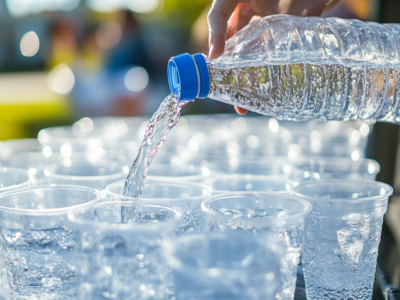Hydration Stations: Helping the Homeless Stay Hydrated in the Heat
Hydration Stations: Helping the Homeless Stay Hydrated in the Heat
As summer temperatures soar, the sweltering heat becomes more than just an inconvenience; it becomes a life-threatening challenge, especially for the homeless population. For those without a permanent shelter, finding relief from the heat and staying hydrated is a daily struggle. Dehydration and heat-related illnesses can lead to severe health complications and, in extreme cases, death. Recognizing this urgent need, several cities and organizations have implemented innovative solutions to ensure that the homeless can stay hydrated and cool during the hot summer months. These initiatives, known as hydration stations, are proving to be a lifeline for those in need.
The Importance of Hydration and Cooling
Before delving into the specifics of hydration stations, it’s essential to understand why these efforts are crucial. Human bodies are composed of approximately 60% water, which is vital for maintaining bodily functions such as regulating temperature, transporting nutrients, and removing waste. In hot weather, the body loses water more rapidly through sweating, increasing the risk of dehydration. For individuals living on the streets, access to clean drinking water and shaded, cool areas is often limited, exacerbating the risk of heat exhaustion and heat stroke.
What are Hydration Stations?
Hydration stations are designated areas where individuals can access free drinking water and, often, additional services such as cooling zones, health check-ups, and refreshments. These stations are strategically located in areas with high homeless populations and are equipped to provide immediate relief from the heat. They are typically set up in public parks, community centers, libraries, and other accessible locations.
Successful Initiatives and Their Impact
Across the United States and beyond, several cities have rolled out successful hydration station programs. Here are some notable examples:
Los Angeles, California
Los Angeles, known for its scorching summer temperatures, has been a pioneer in establishing hydration stations. The city collaborates with local nonprofits and businesses to set up water distribution points in key areas. Additionally, mobile hydration units equipped with water, ice packs, and first aid supplies travel to various locations, ensuring that even the most transient individuals can access these resources. The impact has been significant, with thousands of bottles of water distributed and numerous lives potentially saved.
Phoenix, Arizona
Phoenix, another city notorious for its extreme heat, has taken a comprehensive approach to tackle the issue. The city has installed hydration stations at bus stops, parks, and public buildings. These stations are equipped with water fountains and misting systems to provide instant cooling. Phoenix also partners with local shelters and outreach programs to educate the homeless about the importance of hydration and to distribute water bottles and cooling towels. The collaborative effort has greatly reduced the incidence of heat-related illnesses among the homeless.
New York City, New York
While New York City may not experience the same level of heat as Los Angeles or Phoenix, its summers can still be dangerously hot. The city has set up hydration stations in high-traffic areas such as Times Square and Central Park. These stations not only provide water but also offer shade structures and seating areas. Furthermore, NYC’s Department of Homeless Services runs outreach programs that distribute water and educate the homeless on recognizing the signs of dehydration and heat stroke.
The Role of Nonprofits and Community Organizations
Nonprofits and community organizations play a crucial role in the success of hydration stations. Groups like the Red Cross, Salvation Army, and local homeless shelters are often at the forefront of these efforts. They provide the necessary manpower, resources, and logistical support to set up and maintain the stations. Volunteers distribute water, offer medical assistance, and educate the homeless on staying safe in the heat.
For example, in Austin, Texas, the nonprofit Mobile Loaves & Fishes operates a fleet of food trucks that serve the homeless community. During the summer, these trucks also distribute water and provide information on the nearest hydration stations. The organization collaborates with local businesses and churches to ensure a steady supply of bottled water and other essential supplies.
Challenges and Future Directions
While hydration stations have proven to be a valuable resource, they are not without challenges. Funding is a significant issue, as these initiatives rely heavily on donations and grants. Ensuring a consistent supply of water and maintaining the stations requires ongoing financial support. Additionally, reaching the most vulnerable populations, such as those with mental health issues or substance abuse problems, can be difficult.
To address these challenges, cities and organizations are exploring innovative solutions. Some are considering installing permanent hydration stations with solar-powered water coolers, reducing the reliance on bottled water. Others are developing mobile apps that provide real-time information on the location of hydration stations and other resources for the homeless.
How You Can Help
Supporting hydration station initiatives can make a tangible difference in the lives of the homeless. Here are a few ways you can contribute:
- Donate: Financial contributions to organizations running hydration stations can help maintain and expand these services.
- Volunteer: Offer your time to distribute water, provide medical assistance, or help set up and dismantle stations.
- Spread Awareness: Educate your community about the importance of hydration stations and advocate for local governments to support these initiatives.
- Partner with Businesses: Encourage local businesses to donate water, cooling supplies, or funds to support hydration stations.
Conclusion
Hydration stations are more than just water distribution points; they are a lifeline for the homeless during the harsh summer months. By providing essential resources and a reprieve from the heat, these stations play a crucial role in protecting the health and well-being of vulnerable individuals. As communities continue to recognize the importance of these initiatives, collaboration and innovation will be key to ensuring that no one has to face the dangers of extreme heat alone. Together, we can make a difference and help the homeless stay hydrated and safe.
As summer temperatures soar, the sweltering heat becomes more than just an inconvenience; it becomes a life-threatening challenge, especially for the homeless population. For those without a permanent shelter, finding relief from the heat and staying hydrated is a daily struggle. Dehydration and heat-related illnesses can lead to severe health complications and, in extreme cases, death. Recognizing this urgent need, several cities and organizations have implemented innovative solutions to ensure that the homeless can stay hydrated and cool during the hot summer months. These initiatives, known as hydration stations, are proving to be a lifeline for those in need.
The Importance of Hydration and Cooling
Before delving into the specifics of hydration stations, it’s essential to understand why these efforts are crucial. Human bodies are composed of approximately 60% water, which is vital for maintaining bodily functions such as regulating temperature, transporting nutrients, and removing waste. In hot weather, the body loses water more rapidly through sweating, increasing the risk of dehydration. For individuals living on the streets, access to clean drinking water and shaded, cool areas is often limited, exacerbating the risk of heat exhaustion and heat stroke.
What are Hydration Stations?
Hydration stations are designated areas where individuals can access free drinking water and, often, additional services such as cooling zones, health check-ups, and refreshments. These stations are strategically located in areas with high homeless populations and are equipped to provide immediate relief from the heat. They are typically set up in public parks, community centers, libraries, and other accessible locations.
Successful Initiatives and Their Impact
Across the United States and beyond, several cities have rolled out successful hydration station programs. Here are some notable examples:
Los Angeles, California
Los Angeles, known for its scorching summer temperatures, has been a pioneer in establishing hydration stations. The city collaborates with local nonprofits and businesses to set up water distribution points in key areas. Additionally, mobile hydration units equipped with water, ice packs, and first aid supplies travel to various locations, ensuring that even the most transient individuals can access these resources. The impact has been significant, with thousands of bottles of water distributed and numerous lives potentially saved.
Phoenix, Arizona
Phoenix, another city notorious for its extreme heat, has taken a comprehensive approach to tackle the issue. The city has installed hydration stations at bus stops, parks, and public buildings. These stations are equipped with water fountains and misting systems to provide instant cooling. Phoenix also partners with local shelters and outreach programs to educate the homeless about the importance of hydration and to distribute water bottles and cooling towels. The collaborative effort has greatly reduced the incidence of heat-related illnesses among the homeless.
New York City, New York
While New York City may not experience the same level of heat as Los Angeles or Phoenix, its summers can still be dangerously hot. The city has set up hydration stations in high-traffic areas such as Times Square and Central Park. These stations not only provide water but also offer shade structures and seating areas. Furthermore, NYC’s Department of Homeless Services runs outreach programs that distribute water and educate the homeless on recognizing the signs of dehydration and heat stroke.
The Role of Nonprofits and Community Organizations
Nonprofits and community organizations play a crucial role in the success of hydration stations. Groups like the Red Cross, Salvation Army, and local homeless shelters are often at the forefront of these efforts. They provide the necessary manpower, resources, and logistical support to set up and maintain the stations. Volunteers distribute water, offer medical assistance, and educate the homeless on staying safe in the heat.
For example, in Austin, Texas, the nonprofit Mobile Loaves & Fishes operates a fleet of food trucks that serve the homeless community. During the summer, these trucks also distribute water and provide information on the nearest hydration stations. The organization collaborates with local businesses and churches to ensure a steady supply of bottled water and other essential supplies.
Challenges and Future Directions
While hydration stations have proven to be a valuable resource, they are not without challenges. Funding is a significant issue, as these initiatives rely heavily on donations and grants. Ensuring a consistent supply of water and maintaining the stations requires ongoing financial support. Additionally, reaching the most vulnerable populations, such as those with mental health issues or substance abuse problems, can be difficult.
To address these challenges, cities and organizations are exploring innovative solutions. Some are considering installing permanent hydration stations with solar-powered water coolers, reducing the reliance on bottled water. Others are developing mobile apps that provide real-time information on the location of hydration stations and other resources for the homeless.
How You Can Help
Supporting hydration station initiatives can make a tangible difference in the lives of the homeless. Here are a few ways you can contribute:
- Donate: Financial contributions to organizations running hydration stations can help maintain and expand these services.
- Volunteer: Offer your time to distribute water, provide medical assistance, or help set up and dismantle stations.
- Spread Awareness: Educate your community about the importance of hydration stations and advocate for local governments to support these initiatives.
- Partner with Businesses: Encourage local businesses to donate water, cooling supplies, or funds to support hydration stations.
Conclusion
Hydration stations are more than just water distribution points; they are a lifeline for the homeless during the harsh summer months. By providing essential resources and a reprieve from the heat, these stations play a crucial role in protecting the health and well-being of vulnerable individuals. As communities continue to recognize the importance of these initiatives, collaboration and innovation will be key to ensuring that no one has to face the dangers of extreme heat alone. Together, we can make a difference and help the homeless stay hydrated and safe.







